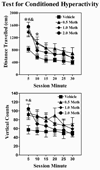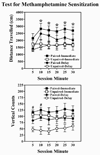Development and persistence of methamphetamine-conditioned hyperactivity in Swiss-Webster mice
- PMID: 21448061
- PMCID: PMC3082579
- DOI: 10.1097/FBP.0b013e328345f741
Development and persistence of methamphetamine-conditioned hyperactivity in Swiss-Webster mice
Abstract
These experiments examined the development and persistence of methamphetamine-conditioned hyperactivity in Swiss-Webster mice. Experiments 1 and 2 examined the development of conditioned hyperactivity, varying the methamphetamine dose (0.25-2.0 mg/kg), the temporal injection parameters (continuous; experiment 1 or intermittent; experiment 2), and the comparison control group (saline; experiment 1 or unpaired; experiment 2). Experiment 3 examined the persistence of methamphetamine-conditioned hyperactivity by comparing mice 1 (immediate) or 28 (delay) days after drug withdrawal. In each experiment, several behavioral measures (vertical counts, distance traveled, and velocity) were recorded and temporal analyses conducted to assess methamphetamine-conditioned hyperactivity. In experiments 1 and 2, it was found that methamphetamine-conditioned hyperactivity was (i) dose-dependent, (ii) detected early in the session, and (iii) detected by a behavioral measure indicative of general activity (i.e. distance traveled), and (iv) varied as a function of the number of conditioning sessions. In experiment 3, it was found that conditioned hyperactivity persisted for 28 days, though was weakened by nonassociative factors, following methamphetamine withdrawal. Collectively, these results suggest that conditioned hyperactivity to methamphetamine is robust and persists after prolonged periods of drug withdrawal in mice. Furthermore, these results are consistent with an excitatory classical conditioning interpretation of conditioned hyperactivity.
Figures




Similar articles
-
Time-dependent effects of prazosin on the development of methamphetamine conditioned hyperactivity and context-specific sensitization in mice.Behav Brain Res. 2014 Apr 15;263:80-9. doi: 10.1016/j.bbr.2014.01.032. Epub 2014 Jan 31. Behav Brain Res. 2014. PMID: 24487011 Free PMC article.
-
Differential effects of voluntary exercise on development and expression of methamphetamine conditioned hyperactivity and sensitization in mice.Pharmacol Biochem Behav. 2020 Jun;193:172934. doi: 10.1016/j.pbb.2020.172934. Epub 2020 Apr 22. Pharmacol Biochem Behav. 2020. PMID: 32333921
-
Timing of SCH 23390 administration influences extinction of conditioned hyperactivity in mice.Behav Pharmacol. 2016 Feb;27(1):73-6. doi: 10.1097/FBP.0000000000000188. Behav Pharmacol. 2016. PMID: 26292185
-
Comparison of cocaine- and methamphetamine-evoked dopamine and glutamate overflow in somatodendritic and terminal field regions of the rat brain during acute, chronic, and early withdrawal conditions.Ann N Y Acad Sci. 2001 Jun;937:93-120. doi: 10.1111/j.1749-6632.2001.tb03560.x. Ann N Y Acad Sci. 2001. PMID: 11458542 Review.
-
Implication of activated astrocytes in the development of drug dependence: differences between methamphetamine and morphine.Ann N Y Acad Sci. 2008 Oct;1141:96-104. doi: 10.1196/annals.1441.032. Ann N Y Acad Sci. 2008. PMID: 18991953 Review.
Cited by
-
Enantiomeric contributions to methamphetamine's bidirectional effects on basal and fentanyl-depressed respiration in mice.Pharmacol Biochem Behav. 2024 May;238:173735. doi: 10.1016/j.pbb.2024.173735. Epub 2024 Feb 17. Pharmacol Biochem Behav. 2024. PMID: 38373600 Free PMC article.
-
Netrin-1 receptor-deficient mice show age-specific impairment in drug-induced locomotor hyperactivity but still self-administer methamphetamine.Psychopharmacology (Berl). 2013 Dec;230(4):607-16. doi: 10.1007/s00213-013-3187-5. Epub 2013 Jul 3. Psychopharmacology (Berl). 2013. PMID: 23820928
-
Repeated chemogenetic activation of dopaminergic neurons induces reversible changes in baseline and amphetamine-induced behaviors.Psychopharmacology (Berl). 2023 Dec;240(12):2545-2560. doi: 10.1007/s00213-023-06448-x. Epub 2023 Aug 18. Psychopharmacology (Berl). 2023. PMID: 37594501 Free PMC article.
-
Role of MT1 melatonin receptors in methamphetamine-induced locomotor sensitization in C57BL/6 mice.Psychopharmacology (Berl). 2014 Jan;231(1):257-67. doi: 10.1007/s00213-013-3228-0. Epub 2013 Aug 11. Psychopharmacology (Berl). 2014. PMID: 23934259 Free PMC article.
-
Propranolol blocks the unconditioned and conditioned hyperactive effects of methamphetamine in CD-1 mice.Behav Pharmacol. 2023 Sep 1;34(6):375-379. doi: 10.1097/FBP.0000000000000742. Epub 2023 Jul 14. Behav Pharmacol. 2023. PMID: 37462146 Free PMC article.
References
-
- Ahmed SH, Cador M, Le Moal M, Stinus L. Amphetamine-induced conditioned activity in rats: Comparison with novelty-induced activity and role of the basolateral amygdale. Behav Neurosci. 1995;109:723–733. - PubMed
-
- Ahmed H, Stinus L, Cador M. Amphetamine-induced conditioned activity is insensitive to perturbations known to affect Pavlovian conditioning responses in rats. Behav Neurosci. 1998;112:1167–1176. - PubMed
-
- Alam MR. Enhancement of Motor- Accelerating Effect Induced by Repeated Administration of Methamphetamine in Mice: Involvement of Environmental Factors. J Pharmacol. 1981;31:897–904. - PubMed
-
- Anagnostaras SG, Robinson TE. Sensitization to the psychomotor stimulant effects of amphetamine: Modulation by associative learning. Behav Neurosci. 1996;110:1397–1414. - PubMed
-
- Bardo MT, Bevins RA. Conditioned place preference: What does it add to our preclinical understanding of drug reward? Psychopharmacology. 2000;153:31–43. - PubMed
Publication types
MeSH terms
Substances
Grants and funding
LinkOut - more resources
Full Text Sources
Medical

